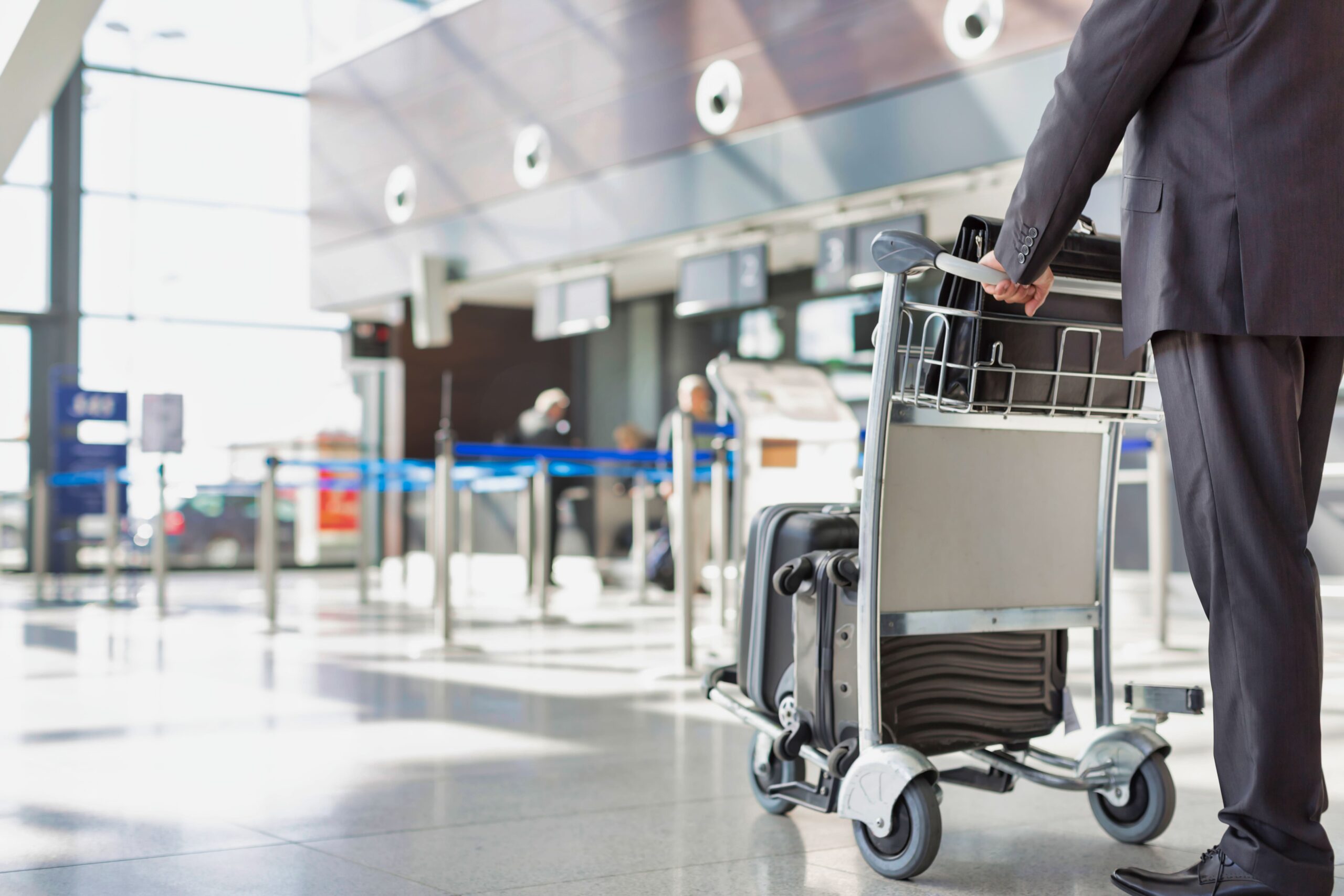The A-Team Inc.

Haider Javed
Project Manager
Muhammad Jabbar
Technical Lead
Preet Grewal
Business Lead
Imteaz Hasan
Modelling Team
Yunfeng He
Simulation Team
Basit Kazi
Simulation Team
The airport industry has seen significant progress in automation technology all over the world. Long airport queues are an altogether too familiar inconvenience for passengers. In many cases, congestion is caused by sudden spikes in passenger numbers, which can place pressure on resources and strain capacity Increasingly, airports around the world are turning to automated and self-service solutions to make passenger processing more efficient.

The aviation industry has been investing heavily in baggage handling systems to improve efficiency, reduce costs, increase reliability and control mishandled baggage. Autonomous vehicles have been identified as one promising application for baggage handling automation.
World Maritime University. Automation in airports (2019)
As part of the Entrepreneurship Capstone course, we took on creating an innovative product within the travel industry that could be pursued as a successful business idea. Considering the increasing trend towards automation it only made sense that our product embodies key principles of automated design. For that reason, The A-Team Inc. created the Automated Luggage Transportation System (ALTS). ALTS offers a unique solution to enhance traditional travel by using power-aided equipment that will provide mental and physical ease and will improve the customer’s travel experience. The solution itself is targeting to help distinguish airports in terms of amenities, to help alleviate fatigue and restlessness felt by people who are tired, preoccupied, have disabilities, reduced mobility, of old age, and families traveling internationally with lots of luggage. ALTS has a unique modular design that allows it to attach to any existing airport trolley that can be found around the world converting it into a “smart trolley”.
Undergoing an iterative design methodology, our team has developed a modular attachment that can be implemented onto the commonly found airport trolleys. The modular attachment includes ultrasonic sensors, an Arduino microprocessor, rotatory and drive DC motors, and a carefully chosen battery to accommodate the power required to carry luggage up to 50kg in weight.

ALTS system attached to a common airport trolley 
Zoomed view of the ALTS system
Our Competitive Advantage:
Our solution utilizes a robust economic model focussing on customer satisfaction and feedback. Our competitive advantage is definitely the fact that our product can be rented which makes it cheaper for users and less of a hassle to incorporate with existing luggage. This makes our product different because consumers will only be charged for every minute of usage after the unlock fee. This also means that users won’t have to buy a separate piece of luggage that has this technology, which would be much more expensive upfront. Users will be able to put multiple pieces of their luggage on the existing trolley rather than owning one automated suitcase. We think that we will be able to persuade customers to choose us over our competitors by advertising the minimal usage fee that comes with our product. Similar to Lime scooters, travelers using our product would pay a small upfront fee and a per-minute cost as they utilize the service
Design Details
HOW OUR DESIGN ADDRESSES PRACTICAL ISSUES
- Comfort: Moving heavy items, such as carry-on and luggage at the airport can be physically exhausting. ALTS provides travelers with the comfort of not requiring to push their luggage manually.
- Target Audience: Tired individuals, people with disabilities, and those of old age have trouble moving objects and pushing carts with luggage on them. ALTS is able to take the burden of luggage off of such travelers to provide a more streamlined and comfortable travel experience. Similarly, travelers who have their hands pre-occupied with small kids, or toddler carts, or food run into trouble when they have luggage.
- COVID-19: Given the current COVID-19 Pandemic, travelers are looking to avoid touching items as much as possible (including push-able carts). With ALTS, the traveler just needs to place their luggage on the cart, and from there, the cart can either be sent to a terminal using pre-determined routes or can follow the passenger using triangular mapping technology enabled by sensors and the Arduino microprocessor.
- Job Growth: In the long term, with widespread airport adaption, there will be an increase in the demand for high skilled jobs which require technical support on the trolleys.
WHAT MAKES OUR DESIGN INNOVATIVE
Modular Design: The unique easy-to-install design of the ALTS robot allows any cart to become a “smart trolley.” This opens up a vast area of innovation in the baggage handling systems within airports, inviting exciting opportunities for investment and a potential increase in high skilled jobs.
WHAT MAKES OUR DESIGN SOLUTION EFFECTIVE
Compact Footprint: Current automated, self-driving luggage bags have a large footprint and small carrying capacity. The ALTS
Intellectual Property: Lack of existing technology allows The A-Team to obtain copyright licenses and design patents.
Unlike the KLM Royal Dutch Airlines robot, ALTS is not limited to a single airline company and is deployable into all locations where existing airport trollies are used. Another competitor is “Smart suitcases”, which provides a single smaller product mainly focused on carry-on case sizes, which must be purchased with a larger upfront cost of ownership. Also, the integrated controller and battery pack further reduce the already limited space and available weight. On the other hand, ALTS is available to be rented by the users for a small fee based on the usage time instead of a single lumpsum payment, which would require their existing suitcases to be replaced. Additionally, considering ALTS’ utilization of typical airport trollies in combination with our modular product, the allowed luggage size and weight limits that airlines hold will not be impacted.
HOW WE VALIDATED OUR DESIGN SOLUTION
To validate the design assumptions, the Simulation team utilized a two-step procedure to run various operational scenarios and measure the performance.
Step 1: MATLAB Demonstration
To understand the manner in which the ALTS would follow a person, we begun with setting up a high-level, simplified MATLAB demonstration. In this demonstration, we are assuming no friction losses, and neither have set up the braking mechanism which would trigger when an obstacle is nearby. Listed below are the four objectives of the MATLAB code:
- Set up a walking trajectory for the person.
- Calculate the reference motor driving speed and steering angle.
- Calculate the position of the cart.
- Compare the trajectory of the person and the cart in plots.
The following video shows the MATLAB demonstration and its results:
https://www.youtube.com/watch?v=04P5g0rrffs&ab_channel=BasitKazi
Step 2: Simulink Model
Using Simulink, we were able to model the behavior of the cart in a more sophisticated manner. Within Simulink, we incorporated real-life elements such as rolling resistance, drag force, and other frictional forces associated with the geometrical set-up of the ALTS and cart combination. The list below provides the objectives of the Simulink model:
- Model the geometrical factors of the cart and ALTS system. This includes the wheel geometry, losses due to air drag, and mass of the cart
- Model both the driving and steering motors, alongside the gearboxes to observe the efficiency and optimize the motor choice
- Model the battery that we chose for our ALTS system. Understand its consumption rate and whether we need a higher or lower capacity battery.
The video linked below describes the various functions and blocks used within the Simulink model:
https://www.youtube.com/watch?v=OJg41NgKLSM&ab_channel=BasitKazi
Simulink Results: Plotting the battery comsumption vs time in seconds
A validation tool we used was plotting the performance/usage of the battery as our simulation runs. This assumes a total mass of 50kg, and a target speed of around 1.2m/s. The simulation completes a total of 200 seconds of run time in which the battery only loses 0.25% of its original 100% charge. The important thing to note from this figure is the way the plot behaves, initially, there is the most amount of load on the motors, as the cart is moving from rest, that is why there is a sharp dip right at the start, but as the cart reaches the stable velocity, the battery usage is almost linear which is expected. These results from the Simulink model help us verify that the motor/gearbox and battery choice that we made are appropriate to our needs.
Under a load of 50kg, and a speed of 1.2 m/s, the battery will last 21 hours.
FEASIBILITY OF OUR DESIGN SOLUTION
Unique Value Proposition: ALTS offers a unique solution to enhance traditional travel by using power-aided equipment that will alleviate fatigue and restlessness associated with traveling which will enhance the customer’s travel experience.
Low Upfront Manufacturing Cost: One unit costs $1300 and can pay itself off quite quickly if users are operating it under the assumed conditions mentioned above.
Lack of Competition: Our product incorporates a unique design when we are compared to other automated luggage solutions. The venture itself is low risk as the unit cost is low and most of the labor will be from our team in the initial phases.
Target Market: We tried to determine the Target Addressable market using different techniques.
One technique was to use the NAICS code: 488119 for Airport baggage handling services which would amount to a $4.8 Billion industry as a whole in 2020 for the United States of America. Further sub classifying in this category as retail stores and hospitality services would account for $527.20 Million (11%) of the whole industry.
Finally, we resorted to estimating our target addressable market using a bottom-up approach in which we considered that approximately 4.92 Billion people were traveling yearly across the world prior to COVID-19. We chose to target 0.25 % of this vast market to account for people who are tired, preoccupied, disabled, have reduced mobility, and old age.
For the first 2 years, we would need roughly $350,000 to operate our product. However, this doesn’t take into account the profits we will be receiving as the months go by. Overall, we will have a net income that is positive even after accounting for our spending.
Media Gallery
SolidWorks Tour of the ALTS system:
https://www.youtube.com/watch?v=jGWo8VmRqjA
To Our Mentors
We want to thank Dr. Jeff Pieper for taking on the role of our Technical Mentor. Dr. Pieper provided invaluable advice and guidance on many aspects of the design and without his contributions, our project could not have reached the advanced stages it is in currently.
We would also like to thank our TA’s Jose Menjivar and Udoko Nwaneto for being approachable, understanding, and supportive throughout the past two semesters.
